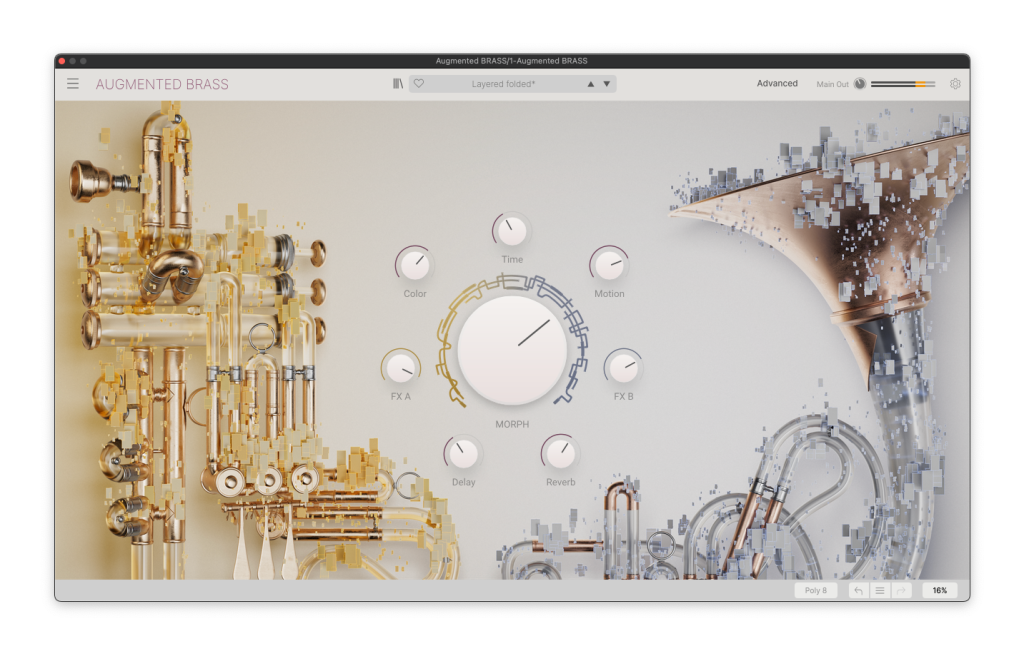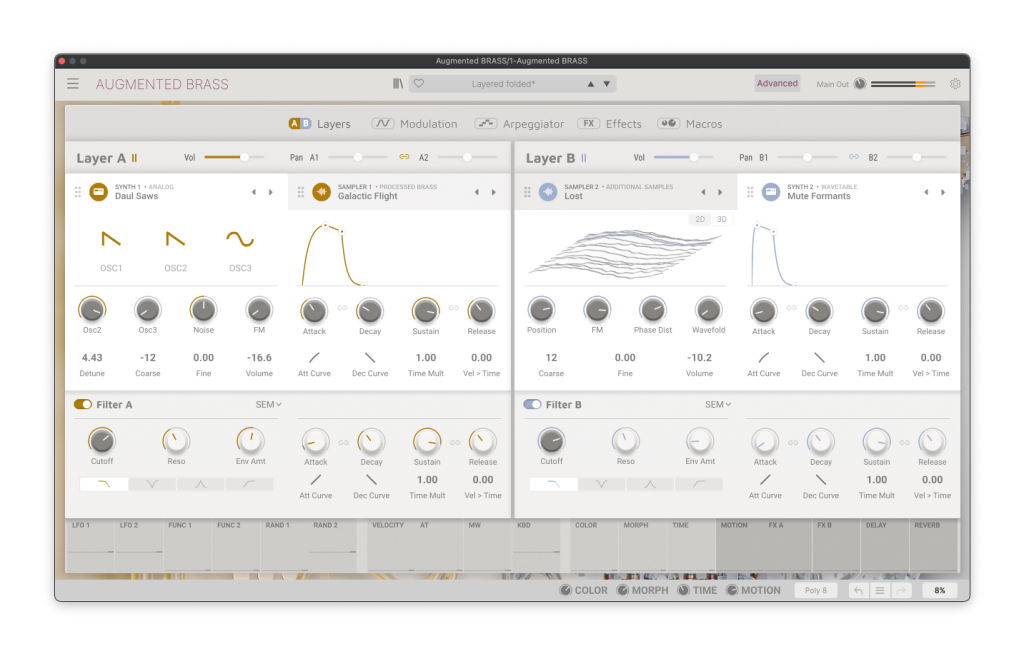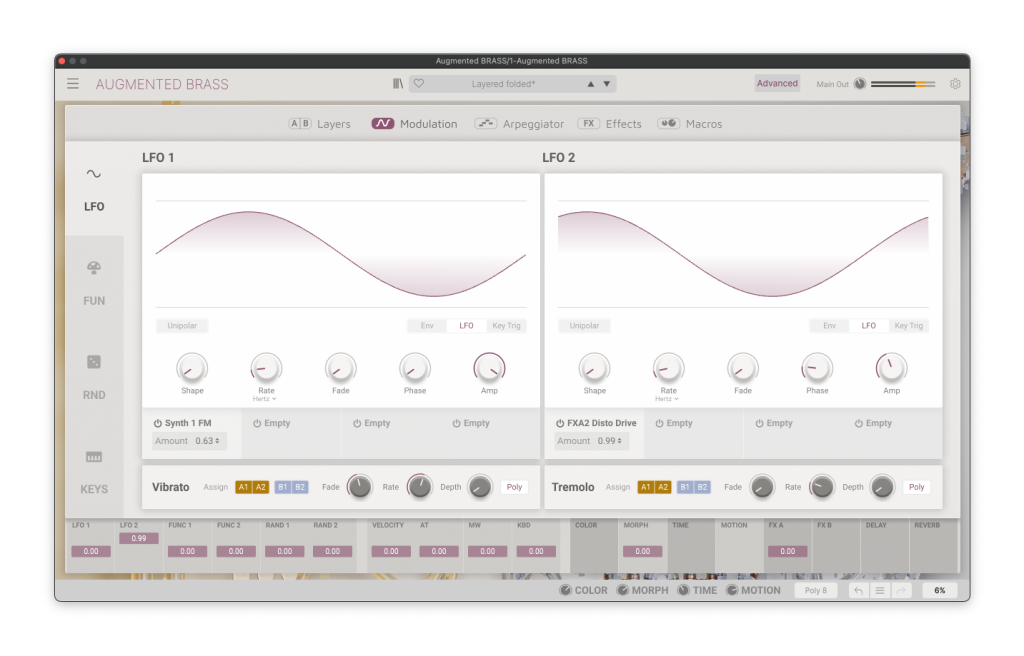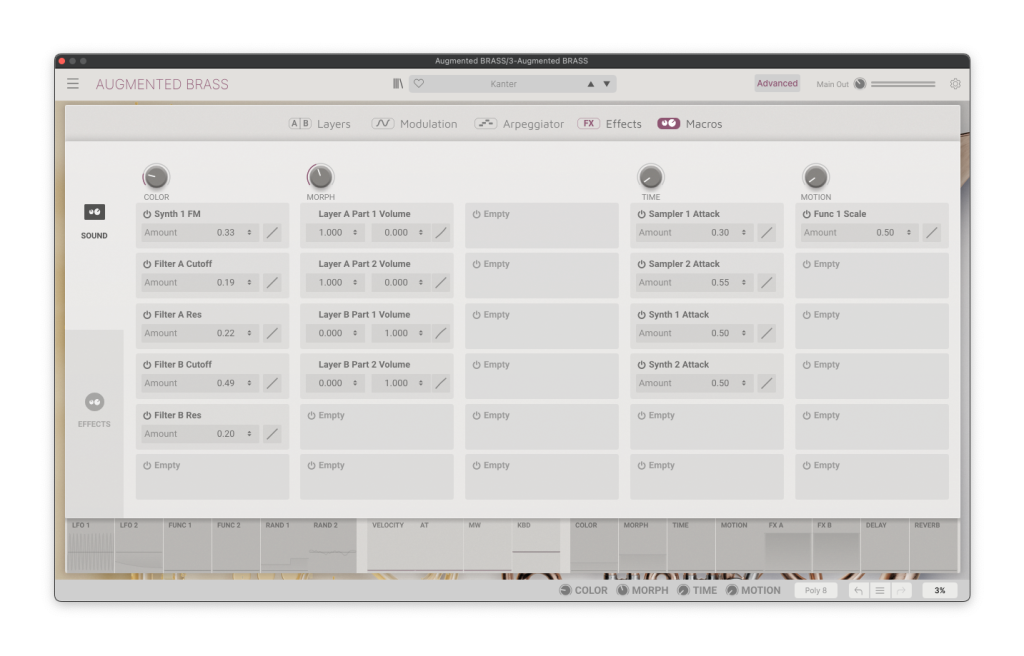Arturia has rounded out its Augmented line with Augmented BRASS. It’s like a hybrid brass plug-in even for people who don’t like brass plug-ins – more like the brass tool for synth lovers.
Is Augmented BRASS even a brass library, in the orchestral/chamber sense? (Yes. Sure. You want some brass sounds from scores, it can be that.) Or is it actually a multi-engine synth with some sampled and granular layers for effect, masquerading as a “brass” instrument? (Absolutely, that, too – enough so you might go to this rather than another synth, at least when you want something brass-ish or with added orchestral impact.)
Note: I hear the criticism in comments about not having modeled sounds here, or the samples being vanilla. But to me, it’s really having the combination of layered samples and synths that’s appealing, and more in the from-scratch sound design category than pulling up factory patches.
Here’s a quick patch I dialed up from scratch in a few minutes, which shows how much you can layer in a single program, combined with effects, for something as synth-y as it is acoustic:
The basic formula here is familiar: merge samples of solo and varying sizes of ensembles, synthesized sounds, and processed combinations. Those sound design tricks have been in vogue for some time in scores and compositions, and have found their way into various libraries and plug-ins from Output, Native Instruments, and partners. But while there are many great-sounding libraries out there, they can become more unwieldy once you start to edit. You wind up either stuck in a sample engine like Kontakt or other odd interfaces, to the extent that I’m sure a lot of folks just dial up presets.
Not so with the Augmented line from Arturia. These offerings have the same polished UI as Arturia’s soft synths – and will be immediately familiar to anyone using other Arturia plug-ins. That also means performance is up to par with the rest of the Arturia library, and you get a brass and synthesized brass tool in your arsenal that is as comfortable for synth lovers as it is for sample library-wonk composers.
If you just want to find some inspiration and tweak it a bit, the standard UI gives you morphing, motion, and effect knobs. But hit “Advanced,” and what you get is an interface beautifully designed around workflow. You’ve got two layers of two engines each (four engines total) with one filter per layer, modulation, arpeggiator, effects slots (two per layer, two master effects), and macros.
That makes Augmented BRASS just as satisfying to use building up from the default template as it is navigating the copious patch library. Inside that interface, you have a complete range of prerecorded materials, plus the full complement of processing and effects tools.

Engines. The engine offerings are now identical (and expanded) across brass, voice, string, and piano tools in the Augmented range. Each layer has one sample and one synth slot. The synth engines:
- Analog: 3-oscillator synth with noise, FM
- Granular: Simple granular synth with density, size, envelope shape
- Harmonic: Additive synth with FM, window, 2 filters with morphing, partial adjustment
- Simpler: Looped, pitched, or one-shot sounds with various samples to choose from (Drone, Field, Foley, Impact, Noise, Pad, and SFX)
- Wavetable: My personal favorite. There are deep chained wavetables here with position, FM, phase distortion, and wavefolding.
Each layer also has a corresponding filter, including not just vanilla multimode but also SEM, comb, formant, and more.

Sample library. In the sampled section, Arturia has included chamber and orchestra instruments with various articulations, synthesized brass, degraded/processed options (including “Betamax” and “VHS” and other tape, analog, and digital lofi stuff), and artistic/experimental selections (labeled “additional”).
I’m of two minds about this: the architecture of the Augmented series is so nice, I do wish you could load your own samples – especially given both sample and granular engines. On the other hand, this isn’t Pigments, and I do like that there are some limitations. Augmented BRASS like its siblings has a particular character. The sample choices aren’t overwhelming. And that’s a good thing, because of the amount you can do with the samples via the engines, effects, and modulation. But yes, maybe if we had that same limitation but could still load our own samples now and then…

Modulation, expression. The Augmented range has a surprisingly deep but approachable modulation and expression architecture. That includes two assignable LFOs with multiple shapes, two bipolar, polyphonic function generators (which can be envelopes or LFOs or key triggers), two random/S&H generators which are also assignable, plus mappable velocity + aftertouch + modulation + key scaling.
Note that you do generally assign these values from the parameter, not the modulation tab. That works well enough, but means more tab-switching than I’d like.
Significantly, you do get MPE (MIDI Polyphonic Expression) support in this as in other Augmented instruments (and a growing roster of Arturia instruments). That’s valuable for expressively controlling all of these parameters, as well as providing ample tuning support.
There is also a full-featured arpeggiator / pattern sequencer / chord sequencer.
Plus, you can assign your own macros to various controls. That puts you in the driving seat as a sound designer, letting you use the main-panel macro controls for your own purposes rather than just being limited to what Arturia’s sound designers have done with their patches.

Effects. The effects engine is as robust as the synth and samples engines, too. Per-layer, you get a range of effects: Multi Filter, Parametric EQ, Compressor, Distortion, Bitcrusher, Chorus, JUNO-60 (“JUN-6”) Chorus, Stereo Pan, Phaser, BL-20 Flanger, Reverb, Digital Delay, Pitch Shift Delay, and Tape Delay.
A lot of these are rich effects with plenty of parameters, almost like having per-layer access to a big chunk of the Arturia FX Collection. And yes, in case you were wondering, that distortion alone is packed with models, just as found in Arturia’s other effects, from wavefolding to Germanium model to simple clipping.
The master FX gives you delay (digital, pitch shift, or tape) and reverb (digital or convolution).

Conclusions. The Augmented range is beautiful as a set. Really, my only question now is, how these fit together – apart from the different sample libraries and pictures on the main screen, these really all the same instrument. I hope that’s not the reason that you can’t load your own samples, as the ability to customize these engines would be really beautiful. But apart from that, having toyed with plenty of similar tools, Arturia really has nailed this one. It’s the perfect synth-acoustic hybrid, and so much a pleasure to use that even more traditional synthesists won’t want to overlook it.
Augmented BRASS is available now. Existing Arturia customers will find discounts when they log in.
Arturia has posted a bunch of additional information with more, if you want to explore more deeply:
